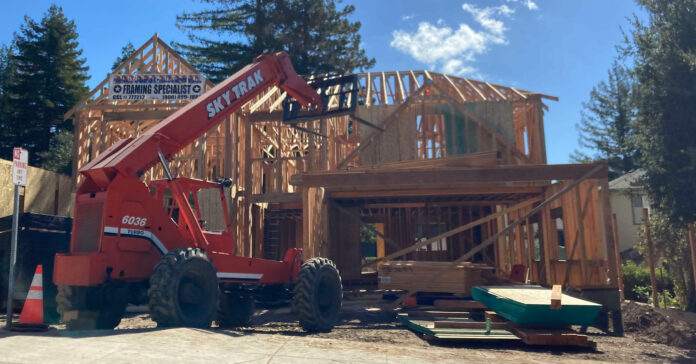
The message of the first report card on Scotts Valley’s draft Housing Element from the State: needs improvement.
Scotts Valley must comply with the California Department of Housing and Community Development’s requirements by the end of the year in order to avoid serious penalties, like losing control over various development decisions.
“The revised draft element addresses some statutory requirements,” said HCD Senior Program Manager Paul McDougall, in an Oct. 3 letter to Scotts Valley Community Development Director Taylor Bateman, “however, revisions will be necessary to comply with State Housing Element Law.”
This is the first formal glimpse into what Sacramento thinks about the strategy Scotts Valley is cooking up to plan for at least 1,220 new homes by the end of 2031 (including 392 very-low-income units, 257 low-income-units, 154 moderate-income-units and 417 above-moderate-income units).
The City of Scotts Valley sent in a draft Housing Element on July 5, then, on Aug. 24, HCD spoke with Senior Planner Sara Wikle, City Attorney Kirsten Powell and consultants Ines Galmiche and Bill Wiseman, and evaluated plan revisions received Sept. 19.
According to McDougall, while the City has covered a lot of terrain, there’s still plenty to cover in the weeks ahead, before it can achieve the HCD stamp of approval.
Communities have to fall in-line with the Housing Element law, otherwise they aren’t eligible for funds from pots of money like the Caltrans’ SB 1 Sustainable Communities Grant, the Affordable Housing and Sustainable Communities program, and HCD’s Permanent Local Housing Allocation. Often, losing control of development decisions is the consequence more front-of-mind for local government officials.
So far, Scotts Valley hasn’t really solicited enough input on what’s called “Affirmatively Furthering Fair Housing,” the national drive to promote integration and reduce segregation, in HCD’s estimation.
“While AFFH outreach can be conducted with the other portions of the housing element, it must also be specific to AFFH,” the letter reads. “For example, the outreach could specifically target fair housing organizations or neighborhoods with relatively concentrated poverty for input related to housing and community development needs and access to opportunities such as education and transportation.”
In fact, the reviewer continued, Scotts Valley still needs to do a more in-depth survey of how its patterns of exclusion relate to the surrounding area.
“The element provided some data on integration and segregation across racial groups within the jurisdiction; however, it must also evaluate patterns at a regional basis, comparing the City to the region.”
HCD said it wants to see more analysis about the unhoused population who reside in and around Scotts Valley.
“In particular, the element should examine patterns of need or areas with higher concentrations of persons experiencing homelessness, including access to transportation and services,” the letter reads.
HCD questioned Scotts Valley’s decision to plan the majority of low and very low-income housing for the area to the west of Green Hills Road and north of Mount Hermon Road known as “Census Tract 1.”
It’s a place with “the largest percent of persons who speak English less than very well” and the highest percentage of renters.
“This area has the lowest median income out of the other two census tracts,” the draft Housing Element states. “As a result, (the) majority of the new housing opportunities in this area were designated to the low-/very low-income households. There are new developments along Scotts Valley Drive where a majority of the resources are concentrated.”
HCD questioned the strategy.
“The element must include analysis and reasoning about the location of sites and impact on current fair housing conditions,” the reviewer said. “The element should discuss whether this strategy potentially isolates a significant number of the housing need for lower-income households and include actions as appropriate to promote inclusive communities and equitable quality of life through the City.”
In the “Contributing Factors” section of the draft Housing Element, Scotts Valley says it’s aware issues with unfair housing do exist, but stresses it’s committed to reducing housing barriers.
“Due to its proximity to Silicon Valley, the City’s average income is the highest in the County and median home prices are also high,” the draft reads. “This may lead to lower income households being priced out. When paired with lower affordable housing options, lower income households and local employees may not be able to find adequate housing within the City and have to commute in from other jurisdictions.”
Scotts Valley also noted a second factor—housing discrimination faced by people with disabilities.
“The element identifies two contributing factors to fair housing issues,” HCD acknowledged. “However, these issues and goals do not appear to be rooted in the AFFH analysis and do not appear adequate to facilitate the formulation of meaningful action to AFFH. The element should reassess contributing factors upon completion of analysis and make revisions as appropriate.”
The Sacramento body wants the City to give more details about why it believes housing will spring-up as projected, and describe how pipeline sites will make it across the finish line. Plus, it wants City planners to be more detailed in their predictions.
Scotts Valley looked at just five residential parcels to come up with its assumption land will turn into housing at a rate of 70% of the maximum-allowed density. In the revised draft, City planners gave a bit more detail.
But HCD still wants to see how things break down by affordability level. The reviewer points out the City could list recent projects by zone, acreage, built density, allowable density, level of affordability and presence of exceptions (such as density bonuses).
The housing authority also pushed Scotts Valley to consider a measure to incentivize the consolidation of sites that would otherwise be too small to accommodate affordable housing, and to look at the likelihood of redevelopment across town.
HCD pointed to the Conditional Use Permit requirement for multi-family housing in the C-S district when located above or behind a ground-level commercial use as a hurdle that might need to be eliminated.
The State also echoed a concern brought up by many locals during public hearings, who said even though the City has agreed to increase the residential cap to 70% (from half) along Scotts Valley Drive, this still might not be enough to spur homebuilding.
In addition, HCD wants Scotts Valley to commit to timelines for streamlining housing production and to incentives for creating affordable units on large sites.
When it comes to looking more deeply at how to eliminate patterns of economic and racial segregation in the majority-white city’s residential quarters, HCD had a few suggestions.
“Actions must have specific commitment, metrics, and milestones as appropriate and must address housing mobility enhancement, new housing choices and affordability in relatively higher opportunity areas, place-based strategies for community preservation and revitalization and displacement protection,” the letter states. “Examples of additional actions could include upzoning areas, increasing housing choices (e.g., duplexes to fourplexes), targeting funding, allowing conversion of existing space beyond state ADU and junior accessory dwelling unit (JADU) laws and homesharing.”
The letter ended with a major demand: that the City step-up its game when it comes to including all segments of the economic spectrum in the Scotts Valley housing conversation.
“The City should employ additional methods for public outreach efforts in the future, particularly to include lower-income and special needs households and neighborhoods with higher concentrations of lower-income households,” McDougall wrote. “For example, the City could conduct targeted stakeholder interviews or establish a committee representative of lower-income households in future public outreach efforts.”
According to Santa Cruz YIMBY, the letter from the State underscores its argument that Scotts Valley hasn’t done enough to analyze and commit to reducing barriers to development.
“This includes but is not limited to: missing middle housing, small and large lot development, monitoring pipeline projects, justifying redevelopment of non-vacant sites, discrete timelines for goals, and affirmatively furthering fair housing,” said Ryan Meckel, the group’s leader.
He says it’s clear Scotts Valley has plenty of work on its plate in the days ahead to revise nearly every section of the critical planning document.
The pro-housing advocates have been skeptical that Scotts Valley will ultimately incentivize development in-practice at all, let alone at the levels of affordability the City is projecting.
“Currently, the only affordable housing proposed in the city is a result of their 15% inclusionary requirement—drastically below the 50% they forecast on nearly every rezoned parcel,” he said.
Meckel agreed with HCD that, at the moment, Scotts Valley has a problem with Census Tract 1—the lowest income area of the City (the only one that isn’t a Racially Concentrated Area of Affluence).
“They aren’t well positioned to fix this issue with their current site inventory and need to look at additional rezoning in Tracts 2 and 3 to more equitably distribute housing opportunities,” he said. “It is worth noting that the Town Center property falls within tract 1.”













